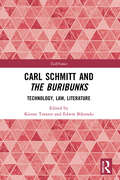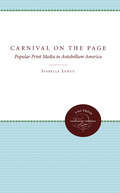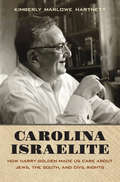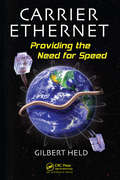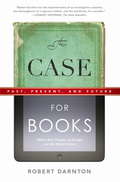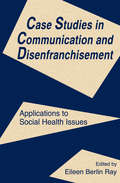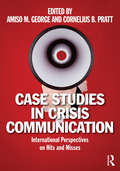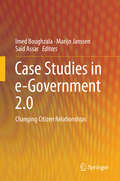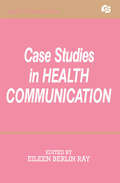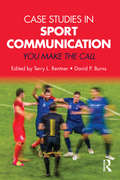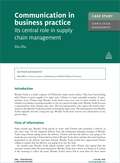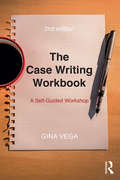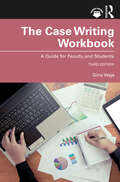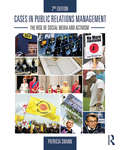- Table View
- List View
Carl Schmitt and The Buribunks: Technology, Law, Literature (TechNomos)
by Edwin Bikundo Kieran TranterIn 1918 a young Carl Schmitt published a short satirical fiction entitled The Buribunks. He imagined a future society of beings who consistently wrote and disseminated their personal diaries. Schmitt would go on to become the infamous philosopher of the exception and for a while the ‘Crown Jurist of the Third Reich’. The Buribunks – ironically for beings that lived only for self-memorialisation – has been mostly lost to history. However, the digital realm, with its emphasis on the informatic traces generated by human doing, and the continual interest in Schmitt’s work to explain and criticise contemporary constellations of power, suggests that The Buribunks is a text whose epoch has come. This volume includes the first full translation into English of The Buribunks and a selection of critical essays on the text, its meanings in the digital present, its playing with and criticism of the literary form, and its place within Schmitt’s life and work. The Buribunks and the essays provide a complex, critical and provocative invitation to reimagine the relations between the human and their imprint and legacy within archives and repositories. There is a fundamental exploration of what it means to be a being intensely aware of ‘writing itself’. This is not just a volume for critical lawyers, literary scholars and the Schmitt literati. It is a volume that challenges a broad range of disciplines, from philosophy to critical data studies, to reflect on the digital present and its assembled and curated beings. It is a volume that provides a set of fantastically located concepts, images and histories that traverse ideas and practices, play and politics, power and possibility.
Carl Schmitt and The Buribunks: Technology, Law, Literature (TechNomos)
by Kieran TranterIn 1918 a young Carl Schmitt published a short satirical fiction entitled The Buribunks. He imagined a future society of beings who consistently wrote and disseminated their personal diaries. Schmitt would go on to become the infamous philosopher of the exception and for a while the ‘Crown Jurist of the Third Reich’. The Buribunks – ironically for beings that lived only for self-memorialisation – has been mostly lost to history. However, the digital realm, with its emphasis on the informatic traces generated by human doing, and the continual interest in Schmitt’s work to explain and criticise contemporary constellations of power, suggests that The Buribunks is a text whose epoch has come. This volume includes the first full translation into English of The Buribunks and a selection of critical essays on the text, its meanings in the digital present, its playing with and criticism of the literary form, and its place within Schmitt’s life and work. The Buribunks and the essays provide a complex, critical and provocative invitation to reimagine the relations between the human and their imprint and legacy within archives and repositories. There is a fundamental exploration of what it means to be a being intensely aware of ‘writing itself’. This is not just a volume for critical lawyers, literary scholars and the Schmitt literati. It is a volume that challenges a broad range of disciplines, from philosophy to critical data studies, to reflect on the digital present and its assembled and curated beings. It is a volume that provides a set of fantastically located concepts, images and histories that traverse ideas and practices, play and politics, power and possibility.
Carnival on the Page: Popular Print Media in Antebellum America
by Isabelle LehuuIn the decades before the Civil War, American society witnessed the emergence of a new form of print culture, as penny papers, mammoth weeklies, giftbooks, fashion magazines, and other ephemeral printed materials brought exuberance and theatricality to public culture and made the practice of reading more controversial. For a short yet pivotal period, argues Isabelle Lehuu, the world of print was turned upside down. Unlike the printed works of the eighteenth century, produced to educate and refine, the new media aimed to entertain a widening yet diversified public of men and women. As they gained popularity among American readers, these new print forms provoked fierce reactions from cultural arbiters who considered them transgressive. No longer the manly art of intellectual pursuit, reading took on new meaning; reading for pleasure became an act with the power to silently disrupt the social order.Neither just an epilogue to an earlier age of scarce books and genteel culture nor merely a prologue to the late nineteenth century and its mass culture and commercial literature, the antebellum era marked a significant passage in the history of books and reading in the United States, Lehuu argues.Originally published 2000.A UNC Press Enduring Edition -- UNC Press Enduring Editions use the latest in digital technology to make available again books from our distinguished backlist that were previously out of print. These editions are published unaltered from the original, and are presented in affordable paperback formats, bringing readers both historical and cultural value.
Carolina Israelite: How Harry Golden Made Us Care about Jews, the South, and Civil Rights
by Kimberly Marlowe HartnettThis first comprehensive biography of Jewish American writer and humorist Harry Golden (1903-1981)--author of the 1958 national best-seller Only in America--illuminates a remarkable life intertwined with the rise of the civil rights movement, Jewish popular culture, and the sometimes precarious position of Jews in the South and across America during the 1950s.After recounting Golden's childhood on New York's Lower East Side, Kimberly Marlowe Hartnett points to his stint in prison as a young man, after a widely publicized conviction for investment fraud during the Great Depression, as the root of his empathy for the underdog in any story. During World War II, the cigar-smoking, bourbon-loving raconteur landed in Charlotte, North Carolina, and founded the Carolina Israelite newspaper, which was published into the 1960s. Golden's writings on race relations and equal rights attracted a huge popular readership. Golden used his celebrity to editorialize for civil rights as the momentous story unfolded. He charmed his way into friendships and lively correspondence with Carl Sandburg, Adlai Stevenson, Robert Kennedy, and Billy Graham, among other notable Americans, and he appeared on the Tonight Show as well as other national television programs. Hartnett's spirited chronicle captures Golden's message of social inclusion for a new audience today.
Carrier Ethernet: Providing the Need for Speed
by Gilbert HeldFacilitating high data transfers over long distances at a reasonable cost, Carrier Ethernet is solidifying its fundamental position as the core of next-generation networks. Since it first dazzled the IT world 40 years ago with its ability to move data over local networks, Ethernet has dramatically evolved in both form and function. And now, Carrier
Carrier Sense Multiple Access (tactile)
by RnibThis diagram shows a carrier sense multiple access network.
The Case for Books: Past, Present, and Future
by Robert DarntonThe era of the printed book is at a crossroad. E-readers are flooding the market, books are available to read on cell phones, and companies such as Google, Amazon, and Apple are competing to command near monopolistic positions as sellers and dispensers of digital information. Already, more books have been scanned and digitized than were housed in the great library in Alexandria. Is the printed book resilient enough to survive the digital revolution, or will it become obsolete? In this lasting collection of essays, Robert Darnton-an intellectual pioneer in the field of this history of the book-lends unique authority to the life, role, and legacy of the book in society.
The Case for Books: Past, Present, and Future
by Robert DarntonThe invention of writing was one of the most important technological, cultural, and sociological breakthroughs in human history. With the printed book, information and ideas could disseminate more widely and effectively than ever before -- and in some cases, affect and redirect the sway of history. Today, nearly one million books are published each year. But is the era of the book as we know it -- a codex of bound pages -- coming to an end? And if it is, should we celebrate its demise and the creation of a democratic digital future, or mourn an irreplaceable loss? The digital age is revolutionizing the information landscape. Already, more books have been scanned and digitized than were housed in the great library in Alexandria, making available millions of texts for a curious reader at the click of a button, and electronic book sales are growing exponentially. Will this revolution in the delivery of information and entertainment make for more transparent and far-reaching dissemination or create a monopolistic stranglehold? In The Case for Books, Robert Darnton, an intellectual pioneer in the field of the history of the book and director of Harvard University's Library, offers an in-depth examination of the book from its earliest beginnings to its shifting role today in popular culture, commerce, and the academy. As an author, editorial advisor, and publishing entrepreneur, Darnton is a unique authority on the life and role of the book in society. This book is a wise work of scholarship -- one that requires readers to carefully consider how the digital revolution will broadly affect the marketplace of ideas.
Case Studies in Communication and Disenfranchisement: Applications To Social Health Issues
by Eileen Berlin RaySee blurb for Communication and Disenfranchisement. Books will be promoted together.
Case Studies in Communication and Disenfranchisement: Applications To Social Health Issues
by Eileen Berlin RaySee blurb for Communication and Disenfranchisement. Books will be promoted together.
Case Studies in Crisis Communication: International Perspectives on Hits and Misses
by Amiso M. George Cornelius B. PrattCase Studies in Crisis Communication: International Perspectives on Hits and Misses was created to fill the gap for a much-needed textbook in case studies in crisis communication from international perspectives. The events of September 11, 2001, other major world crises, and the ongoing macroeconomic challenges of financial institutions, justify the need for this book. While existing textbooks on the subject focus on U.S. corporate cases, they may not appeal equally to students and practitioners in other countries, hence the need to analyze cases from the United States and from other world regions. The variety and the international focus of the cases, be they environmental, health or management successes or failures, makes this book more appealing to a wider audience. These cases examine socio-cultural issues associated with responding to a variety of crises.
Case Studies in Crisis Communication: International Perspectives on Hits and Misses
by Amiso M. George Cornelius B. PrattCase Studies in Crisis Communication: International Perspectives on Hits and Misses was created to fill the gap for a much-needed textbook in case studies in crisis communication from international perspectives. The events of September 11, 2001, other major world crises, and the ongoing macroeconomic challenges of financial institutions, justify the need for this book. While existing textbooks on the subject focus on U.S. corporate cases, they may not appeal equally to students and practitioners in other countries, hence the need to analyze cases from the United States and from other world regions. The variety and the international focus of the cases, be they environmental, health or management successes or failures, makes this book more appealing to a wider audience. These cases examine socio-cultural issues associated with responding to a variety of crises.
Case Studies in e-Government 2.0: Changing Citizen Relationships
by Imed Boughzala Marijn Janssen Saïd AssarThe goal of this book is to provide a comprehensive, multi-dimensional approach to research and practice in e-government 2.0 implementation. Contributions from an international panel of experts apply a variety of methodological approaches and illustrative case studies to present state-of-the-art analysis and perspectives.Around the world, governments are employing technological advancements to revolutionize their ways of working, resulting in changing relationships among public organizations and their constituents. Important enablers are new uses of information and knowledge-sharing technologies that emerged with the advent of the Web 2.0 paradigm; initially used in the private arena, such user-friendly, participatory, intuitive and flexible Web 2.0 technologies (e.g., blogs, Wikis, RSS, social networking platforms, folksonomy, podcasting, mashups, virtual worlds, open linked data, etc.) are increasingly disseminated within the professional sphere, regardless of organization type or field of activities.Current e-government environments have undergone considerable transformations in an attempt to satisfy the incessant demand for more advanced e-service delivery, better access to information and more efficient government management. Looking to the future, the emergence of Web 2.0, the rise of social networks and the wider dissemination of data and information are expected to generate many benefits, such as a better match between public services and citizens' expectations, greater adoption of online services by citizens and better control of costs and prevention of delays in the implementation of new services. Governments around the world are building frameworks and proposals for e-government 2.0, in the hopes of improving participation, transparency and integration, while speeding up the pace of innovation through collaboration and consultation.This volume addresses a gap in the research literature, offering timely insights on the e-government 2.0 phenomenon and directions for future practice and policy.
Case Studies in Health Communication: A Case Study Approach (Routledge Communication Series)
by Eileen Berlin RayThis book focuses on the complexities of the communication of health-related messages and information through the use of case studies. The expert contributors to this volume are scholars who, during their research and consulting, grapple with many of the issues of concern to those studying health communication. While several introductory books offer brief case studies to illustrate concepts covered, this book provides in-depth cases that enable more advanced students to apply theory to real situations.
Case Studies in Health Communication (Routledge Communication Series)
by Eileen Berlin RayThis book focuses on the complexities of the communication of health-related messages and information through the use of case studies. The expert contributors to this volume are scholars who, during their research and consulting, grapple with many of the issues of concern to those studying health communication. While several introductory books offer brief case studies to illustrate concepts covered, this book provides in-depth cases that enable more advanced students to apply theory to real situations.
Case Studies in Sport Communication: You Make the Call
by Terry L. Rentner David P. BurnsCase Studies in Sport Communication: You Make the Call goes beyond the box scores by offering readers the opportunity to evaluate popular and diverse issues in sport—including management, crisis, health, ethics, gender, race, and social media. Each chapter incorporates theory and communication principles as well as topical background information, and concludes with discussion questions and engaging assignments. This volume presents real-life, provocative sports cases that bring contemporary headlines into perspective and inspire critical thinking. Each chapter features scholarly evidence that will keep the conversation lively, thoughtful, and informative. Students are encouraged to challenge the ethical implications of what they have read and to “make the call.” This is an invaluable resource for upper-level undergraduate and graduate students of sport communication and sport management.
Case Studies in Sport Communication: You Make the Call
by Terry L. Rentner David P. BurnsCase Studies in Sport Communication: You Make the Call goes beyond the box scores by offering readers the opportunity to evaluate popular and diverse issues in sport—including management, crisis, health, ethics, gender, race, and social media. Each chapter incorporates theory and communication principles as well as topical background information, and concludes with discussion questions and engaging assignments. This volume presents real-life, provocative sports cases that bring contemporary headlines into perspective and inspire critical thinking. Each chapter features scholarly evidence that will keep the conversation lively, thoughtful, and informative. Students are encouraged to challenge the ethical implications of what they have read and to “make the call.” This is an invaluable resource for upper-level undergraduate and graduate students of sport communication and sport management.
Case Study: Its Central Role in Supply Chain Management (Kogan Page Case Study Library)
by Xia ZhuCommunication is fundamental for exchanging information in a timely manner in order to facilitate a wide range of business interactions. Communication in Business Practice looks at communication between businesses and offers advice on how it can be improved in a supply chain management context. Aimed at students on supply chain management and logistics courses, it explains how to relate to other businesses and stakeholders internally and externally. Communication in Business Practice highlights pitfalls to avoid, offers the reader some essential techniques for best practice, and focuses on key aspects of communication in business. These tools will improve cross-functional activities and increase profit as well as forging stronger networks and relationships with suppliers.Register for a Kogan Page account at check-out to access and download your PDF after purchasing. You'll also have an opportunity to sign up when receiving your purchase confirmation email.
Case Study: Its Central Role in Supply Chain Management (Kogan Page Case Study Library)
by Xia ZhuCommunication is fundamental for exchanging information in a timely manner in order to facilitate a wide range of business interactions. Communication in Business Practice looks at communication between businesses and offers advice on how it can be improved in a supply chain management context. Aimed at students on supply chain management and logistics courses, it explains how to relate to other businesses and stakeholders internally and externally. Communication in Business Practice highlights pitfalls to avoid, offers the reader some essential techniques for best practice, and focuses on key aspects of communication in business. These tools will improve cross-functional activities and increase profit as well as forging stronger networks and relationships with suppliers.Register for a Kogan Page account at check-out to access and download your PDF after purchasing. You'll also have an opportunity to sign up when receiving your purchase confirmation email.
The Case Writing Workbook: A Self-Guided Workshop
by Gina VegaThis book offers a modular set of chapters that focus specifically on the challenges related to case writing. Exercises, worksheets, and training activities help guide readers sequentially through the entire process of writing both a case and an instructor’s manual (teaching note). Designed as an individualized workshop to assist case authors to structure their writing, this book combines the easy-to-understand, student-focused language of the first edition with new material covering the latest developments and challenges in the world of case writing. These include: ? A section on writing cases in condensed time frames ? A new module on writing short cases in various formats ? A new module on turning research papers into teaching tools ? A section about growing communities of practice in a university ? An expansion of the student case writing module to include a section on case writing for graduate students ? Twelve new worksheets ? A complete index to facilitate use of the book Finishing all the book’s assignments will result in a complete case and instructor’s manual that can be tested in the classroom and submitted to a conference or journal. The Case Writing Workbook is a must for the shelf of any academic or student conducting qualitative research and looking to enhance their skill set.
The Case Writing Workbook: A Self-Guided Workshop
by Gina VegaThis book offers a modular set of chapters that focus specifically on the challenges related to case writing. Exercises, worksheets, and training activities help guide readers sequentially through the entire process of writing both a case and an instructor’s manual (teaching note). Designed as an individualized workshop to assist case authors to structure their writing, this book combines the easy-to-understand, student-focused language of the first edition with new material covering the latest developments and challenges in the world of case writing. These include: ? A section on writing cases in condensed time frames ? A new module on writing short cases in various formats ? A new module on turning research papers into teaching tools ? A section about growing communities of practice in a university ? An expansion of the student case writing module to include a section on case writing for graduate students ? Twelve new worksheets ? A complete index to facilitate use of the book Finishing all the book’s assignments will result in a complete case and instructor’s manual that can be tested in the classroom and submitted to a conference or journal. The Case Writing Workbook is a must for the shelf of any academic or student conducting qualitative research and looking to enhance their skill set.
The Case Writing Workbook: A Guide for Faculty and Students
by Gina VegaThis case writing workbook offers something unique in the world of case writing manuals. The third edition of The Case Writing Workbook: A Guide for Faculty and Students provides 11 standalone chapters that focus specifically on challenges related to the case writing process. The book is meant for day-to-day use as a model of the case writing process, with exercises, worksheets, and training activities that will guide you through the entire course of writing both a traditional case and Instructor’s Manual or a concise/short case and its associated Teaching Note. Brief explanatory notes will lead you step-by-step through all the developmental exercises, including readying the case for publication and teaching it in the classroom or online. Designed as an individualized workshop to assist case authors to structure their writing, this book combines the easy-to-understand, student-focused language with new material covering the latest developments and challenges in the world of case writing. These include: • A fresh focus on writing and teaching concise cases, which are particularly suited to the world of blended learning. • Emphasis on secondary research methodology, particularly using digital technologies and social media. • A new case study running throughout the book, with restructured worksheets and notes to support it. • Enhanced online case teaching information and discussion of the development of multi-media cases, particularly using video. Complete instructor’s materials to support the text are available online, including PowerPoint presentations, guidance on embedding cases within the curriculum, a sample syllabus that incorporates cases within it, and selected student assignments and handouts. Finishing all the book’s assignments will result in a complete case and Instructor’s Manual that can be tested in the classroom and submitted to a conference or journal. The Case Writing Workbook is a must for the shelf of any academic or student conducting qualitative research and looking to enhance their skill set, and any instructor working with cases in their teaching.
The Case Writing Workbook: A Guide for Faculty and Students
by Gina VegaThis case writing workbook offers something unique in the world of case writing manuals. The third edition of The Case Writing Workbook: A Guide for Faculty and Students provides 11 standalone chapters that focus specifically on challenges related to the case writing process. The book is meant for day-to-day use as a model of the case writing process, with exercises, worksheets, and training activities that will guide you through the entire course of writing both a traditional case and Instructor’s Manual or a concise/short case and its associated Teaching Note. Brief explanatory notes will lead you step-by-step through all the developmental exercises, including readying the case for publication and teaching it in the classroom or online. Designed as an individualized workshop to assist case authors to structure their writing, this book combines the easy-to-understand, student-focused language with new material covering the latest developments and challenges in the world of case writing. These include: • A fresh focus on writing and teaching concise cases, which are particularly suited to the world of blended learning. • Emphasis on secondary research methodology, particularly using digital technologies and social media. • A new case study running throughout the book, with restructured worksheets and notes to support it. • Enhanced online case teaching information and discussion of the development of multi-media cases, particularly using video. Complete instructor’s materials to support the text are available online, including PowerPoint presentations, guidance on embedding cases within the curriculum, a sample syllabus that incorporates cases within it, and selected student assignments and handouts. Finishing all the book’s assignments will result in a complete case and Instructor’s Manual that can be tested in the classroom and submitted to a conference or journal. The Case Writing Workbook is a must for the shelf of any academic or student conducting qualitative research and looking to enhance their skill set, and any instructor working with cases in their teaching.
Cases In Online Interview Research
by Janet Salmons"This is foundational and state-of-the-art for online interviewing methods and technologies…. I salute all of the participants for doing such a wonderful job with it."-John M. Johnson, Arizona State University "The editor has made meticulous efforts to place the various chapters within a useful grid of interpretation, and this will aid readers′ understanding and use of the material."-S.E. Bennett, Carleton University In an era of constrained research budgets, online interviewing opens up immense possibilities: A researcher can literally conduct a global study without ever leaving home. But more than a decade after these technologies started to become available, there are still few studies on how to utilize online interviews in research. This book provides 10 cases of research conducted using online interviews, with data collected through text-based, videoconferencing, multichannel meeting, and immersive 3-D environments. Each case is followed by two commentaries: one from another expert contributor, the second from Janet Salmons as editor. A open-access companion website provides sample syllabi, assignment ideas, links to other work by the book′s contributors, and guidelines for utilizing the book′s E-Interview Research Framework.
Cases in Public Relations Management: The Rise of Social Media and Activism
by Patricia SwannDeveloped for advanced students in public relations, Cases in Public Relations Management uses recent cases in public relations that had outcomes varying from expected to unsuccessful. The text challenges students to think analytically, strategically, and practically. Each case is based on real events, and is designed to encourage discussion, debate, and exploration of the options available to today's strategic public relations manager. Key features of this text include coverage of the latest controversies in current events, discussion of the ethical issues that have made headlines in recent years, and strategies used by public relations practitioners. Each case has extensive supplemental materials taken directly from the case for students' further investigation and discussion. The case study approach encourages readers to assess what they know about communication theory, the public relations process, and management practices, and prepares them for their future careers as PR practitioners. New to the second edition are: 27 new case studies, including coverage of social media and social responsibility elements New chapters on corporate social responsibility (CSR) and activism End-of-chapter exercises Embedded hyperlinks in eBook Fully enhanced companion website that includes: Instructor resources: PowerPoint presentations, Video Clips, Case Supplements, Instructor Guides Student resources: Quizzes, Glossary, Case Supplements
